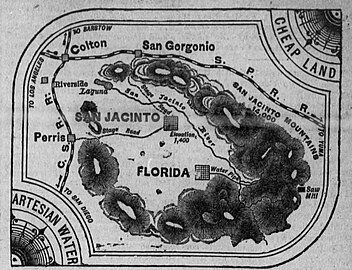
San Jacinto is a city in Riverside County, California, United States. It is located at the north end of the San Jacinto Valley, with Hemet to its south and Beaumont, California, to its north. The mountains associated with the valley are the San Jacinto Mountains. The population was 44,199 at the 2010 census. The city was founded in 1870 and incorporated on April 20, 1888, making it one of the oldest cities in Riverside County.
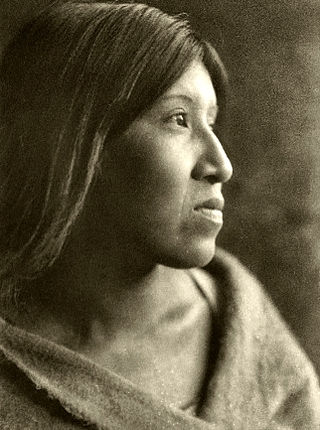
The Cahuilla, also known as ʔívil̃uqaletem or Ivilyuqaletem, are a Native American people of the various tribes of the Cahuilla Nation, living in the inland areas of southern California. Their original territory included an area of about 2,400 square miles (6,200 km2). The traditional Cahuilla territory was near the geographic center of Southern California. It was bounded to the north by the San Bernardino Mountains, to the south by Borrego Springs and the Chocolate Mountains, to the east by the Colorado Desert, and to the west by the San Jacinto Plain and the eastern slopes of the Palomar Mountains.

The Luiseño or Payómkawichum are an Indigenous people of California who, at the time of the first contacts with the Spanish in the 16th century, inhabited the coastal area of southern California, ranging 50 miles (80 km) from the present-day southern part of Los Angeles County to the northern part of San Diego County, and inland 30 miles (48 km). In the Luiseño language, the people call themselves Payómkawichum, meaning "People of the West." After the establishment of Mission San Luis Rey de Francia, "the Payómkawichum began to be called San Luiseños, and later, just Luiseños by Spanish missionaries due to their proximity to this San Luis Rey mission.
Gilman Hot Springs is an unincorporated community in Riverside County, California. It lies along California State Route 79, adjacent to the San Jacinto campus of Mt. San Jacinto College.

Robert Stacy-Judd (1884–1975) was an English architect and author who designed theaters, hotels, and other commercial buildings in the Mayan Revival architecture Style in Great Britain and the United States. Stacy-Judd's synthesis of the style used Maya architecture, Aztec architecture, and Art Deco precedents as his influences.
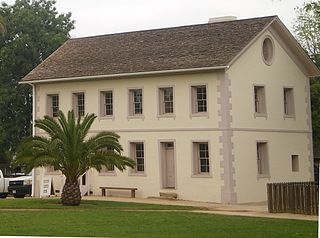
Los Encinos State Historic Park is a state park unit of California, preserving buildings of Rancho Los Encinos. The park is located near the corner of Balboa and Ventura Boulevards in Encino, California, in the San Fernando Valley. The rancho includes the original nine-room de la Ossa Adobe, the two-story limestone Garnier building, a blacksmith shop, a natural spring, and a pond. The 4.7-acre (1.9 ha) site was established as a California state park in 1949.
The Soboba Golf Classic was a golf tournament on the Web.com Tour. It was played at The Country Club at Soboba Springs, owned by the Soboba Band of Luiseno Indians, in San Jacinto, California. It was first played in 2009.
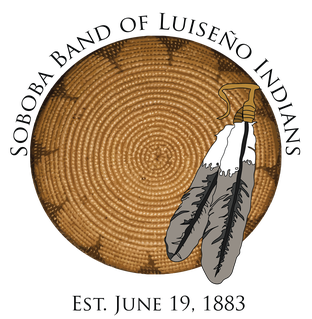
The Soboba Band of Luiseño Indians is a federally recognized tribe of Luiseño people, headquartered in Riverside County, California. On June 18, 1883, the Soboba Reservation was established by the United States government in San Jacinto. There are five other federally recognized tribes of Luiseño people in southern California.

Gilman Hot Springs, also known as San Jacinto Hot Springs or the Relief Springs, is a hot spring system in the Inland Empire area of Southern California. Located near Potrero Creek, the San Jacinto River, and California State Route 79, the springs system consists of "about half a dozen" springs named for the Mexican land grant Rancho San Jacinto Viejo.

Riverside County is a county located in the southern portion of the U.S. state of California. As of the 2020 census, the population was 2,418,185, making it the fourth-most populous county in California and the 10th-most populous in the United States. The name was derived from the city of Riverside, which is the county seat.

Rancho Temescal was a farming outpost of Mission San Luis Rey de Francia, one of the 21 Franciscan missions established in California by Spain during the late 18th and early 19th centuries. The Mission was located on the coast where Oceanside, California is today. The Rancho was settled in 1819 by Leandro Serrano, and became the first non-native settlement within the boundaries of what would become Riverside County, California.

Seminole Hot Springs is an unincorporated community in Los Angeles County, California, United States. Seminole Hot Springs is located in the Santa Monica Mountains near Cornell, 3.6 miles (5.8 km) south-southeast of Agoura Hills at an elevation of 932 feet (284 m).

Wheeler Springs is an unincorporated community that grew around a set of sulphurated hot springs in Ventura County, California. It is located 6 miles north of the Ojai Valley, within Los Padres National Forest. It is named for Wheeler Blumberg, who founded the town in 1891, and the many natural hot springs.
The 1899 San Jacinto earthquake occurred on Christmas morning at 04:25 local time in Southern California. The estimated moment magnitude 6.7 earthquake had an epicenter located 10 miles southeast of San Jacinto. The earthquake had a maximum Mercalli intensity of IX (Violent). Severe damage occurred, amounting to US$50,000, as well as six fatalities.

Encino Hot Springs are historic thermal springs located at the site of Siutcanga village, a settlement of the Tongva-Kizh people of the area now known as Southern California. It was used by several tribes of Indigenous peoples for thousands of years. Later, after settlement, the artesian springs were used as a water source for Rancho Los Encinos in what is now the San Fernando Valley region of Los Angeles County, California. In the 1880s it was a rest stop on the Butterfield Stagecoach route. The springs are located in the modern-day Los Encinos State Historic Park.
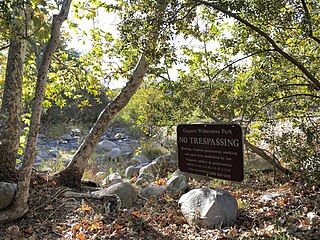
San Juan Hot Springs, also San Juan Capistrano Hot Springs, is a geothermal area in what is now Ronald W. Caspers Wilderness Park, near Cleveland National Forest, in Orange County, California in the United States. The springs were used by the Indigenous peoples of the region, and were an integral part of the dominion of Misíon San Juan Capistrano. They were later developed and used, on and off for a hundred years, as a resort area of post-settlement Southern California. The 52 springs were designated Orange County Historic Landmark No. 38 in 1989.
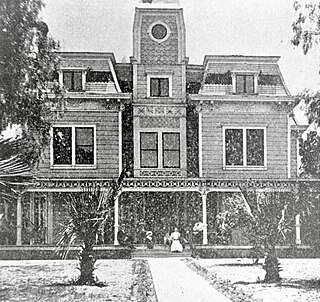
Fairview Hot Springs was a resort hotel in Fairview, California, United States from about 1887 to about 1918. The source of the water that constituted the "hot springs" was actually a well that yielded a combination of heated artesian water and natural gas. The Fairview Hot Springs was known for its mudbaths, but the Fairview development was already languishing, when—due to either financial failure generally, or the 1918 San Jacinto earthquake specifically—the resort hotel closed its doors for good around 1918.
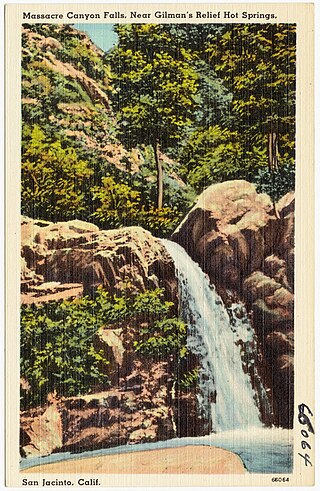
Potrero Creek is a minor waterway of Riverside County, California in the United States. Potrero Creek has a 5-mile (8.0 km)-long course and flows south through the San Jacinto River basin. Potrero Creek drains about 35 square miles (91 km2) of the San Jacinto Mountains. Potrero joins the San Jacinto River near California State Route 79, at Gilman Hot Springs, California. There are reportedly a small group of cave shelters along Potrero Creek in Massacre Canyon, south of Beaumont, on what was called the Stanton Ranch in 1962. Massacre Canyon supposedly gets its name from a battle that took place around 1540, when Temecula people massacred defenders of a village of the tribe now known as the Soboba Band of Luiseño Indians, which was called Ivah and was located at what is now Gilman Hot Springs, California.

Eden Hot Springs was a historic hot springs and resort in Riverside County, California, United States.

Urbita Hot Springs was a historic hot springs and amusement park in San Bernardino County, California, United States. Urbita Springs Park was located between E Street and Colton Street in San Bernardino where the Inland Center mall stands today.








